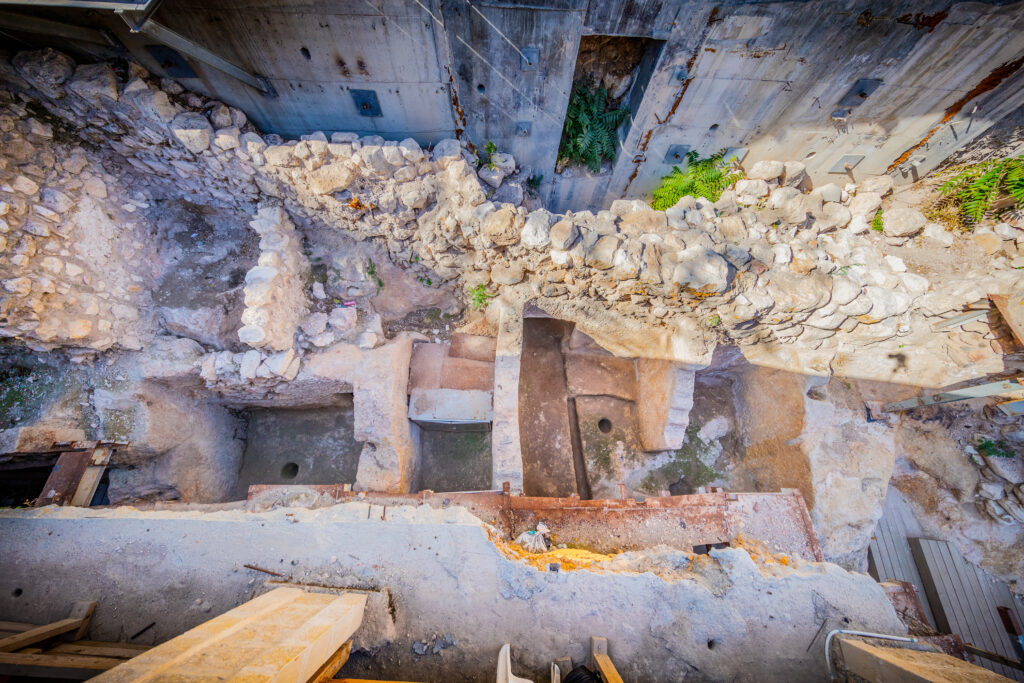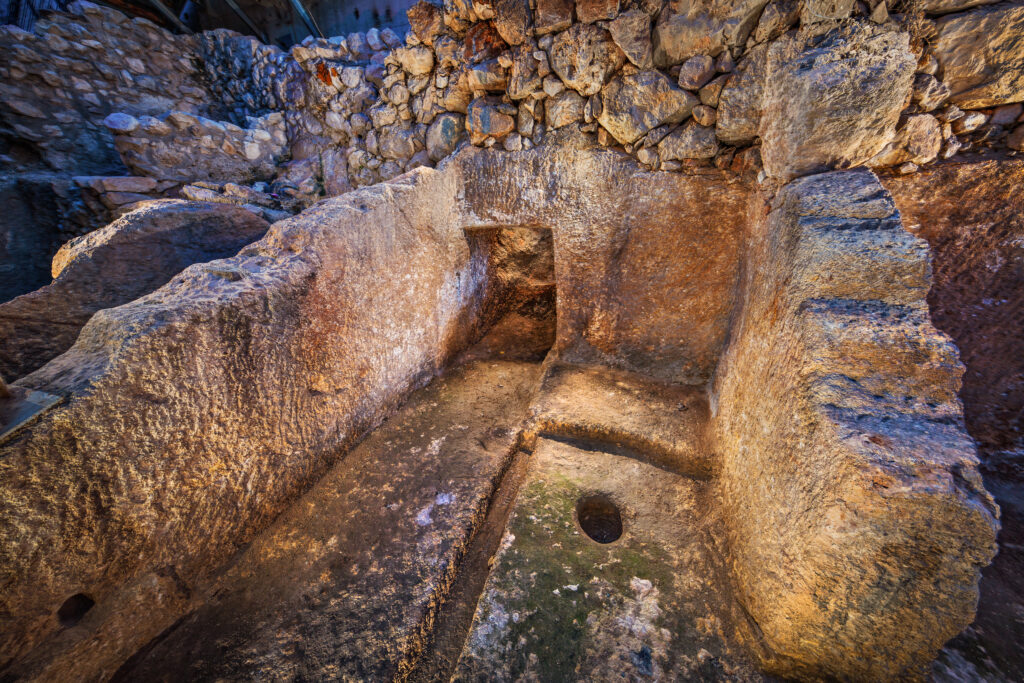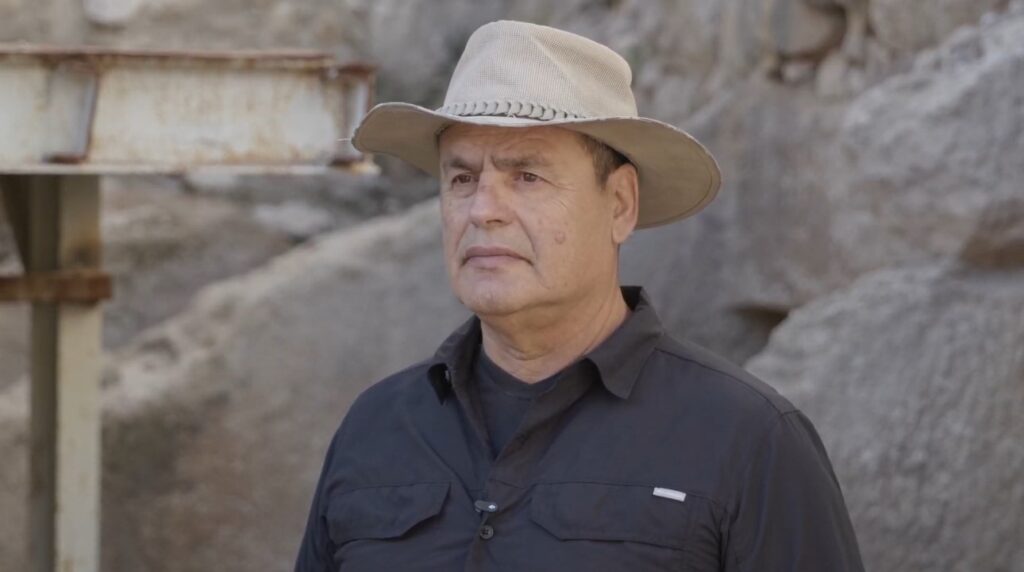In a groundbreaking archaeological discovery, researchers have unearthed a unique ritual complex on the eastern slope of Jerusalem’s City of David, offering unprecedented insights into religious practices during the First Temple period. The structure, featuring eight intricately carved rooms and various ritual installations, represents the only known ceremonial structure from this era in Jerusalem and one of the few discovered throughout Israel.

Aerial view of the ritual structure: eight rooms spanning an area of approximately 220 square meters. Credit: Kobi Harati, City of David.
Remarkable Features and Layout
The newly excavated complex, spanning approximately 220 square meters, contains eight rooms carved directly into the bedrock. Each room served a distinct purpose, as evidenced by their specialized installations. The complex includes an oil press for ceremonial oil production and a wine press for ritual wine-making. Perhaps most significantly, researchers discovered a carved altar complete with drainage channels alongside a prominent standing stone (masseba) that was likely used for religious ceremonies. One of the rooms features mysterious V-shaped markings on its floor, which archaeologists believe may have supported a ritual tripod.

The standing stone uncovered during the excavation: “The most significant and dramatic find revealed.” Credit: Vladimir Naikhin, Israel Antiquities Authority.
Significant Artifacts Uncovered
A small cave within the complex yielded a treasure trove of eighth-century BCE artifacts, providing valuable context about the structure’s use. The archaeological team uncovered pottery vessels bearing ancient Hebrew inscriptions, traditional loom weights, and an array of decorative items, including scarabs and stamped seals. The discovery of grain-grinding stones and various cooking vessels further illuminates the daily activities in this sacred space.

The ritual structure discovered in the City of David—the only one of its kind from this period found in Jerusalem. Credit: Kobi Harati, City of David.
Historical Context and Religious Reforms
The complex’s operational period coincided with the reign of the Kings of Judah, functioning until the eighth century BCE. According to excavation director Eli Shukron, the structure’s abandonment likely correlates with King Hezekiah’s religious reforms, which aimed to centralize worship at the Temple Mount.

An oil press and a winepress nearby: used for producing small quantities of oil and wine for ritual purposes. Credit: Kobi Harati, City of David.
The excavation reveals that the site was deliberately filled and sealed during the eighth century BCE, preserving many features in remarkable condition. The standing stone, in particular, remained perfectly positioned in its original location, offering invaluable archaeological evidence of ancient religious practices.

A carved installation identified as an altar, with a channel for liquid drainage. Credit: Kobi Harati, City of David.
Archaeological Legacy
While the current excavation began in 2010, the site’s archaeological significance dates back to 1909, when British explorer Montague Parker first discovered its northern section while searching for the Ark of the Covenant and Temple treasures. The recent comprehensive excavation, led by Eli Shukron for the Israel Antiquities Authority, has finally revealed this historic structure’s full extent and importance.

Archaeologist Eli Shukron—author of the article and director of the excavation on behalf of the Israel Antiquities Authority in the City of David. Credit: Asaf Peri, City of David.
The complete findings have been published in ‘Atiqot, the Israel Antiquities Authority’s scientific journal, and are now freely accessible through the IAA’s new digital publications platform, making this significant discovery available to scholars and the public alike.

A scarab seal from the 8th century BCE uncovered during the excavation. Credit: Vladimir Naikhin, Israel Antiquities Authority.
Israel’s Minister of Heritage, Amichai Eliyahu, emphasized the discovery’s cultural significance, stating that such findings provide tangible evidence of Jerusalem’s rich historical heritage and the Jewish people’s ancient roots in the region.
This remarkable find, situated just hundreds of meters from the Temple Mount, continues to enhance our understanding of religious practices in ancient Jerusalem and provides valuable insights into the complex spiritual landscape of the First Temple period.




